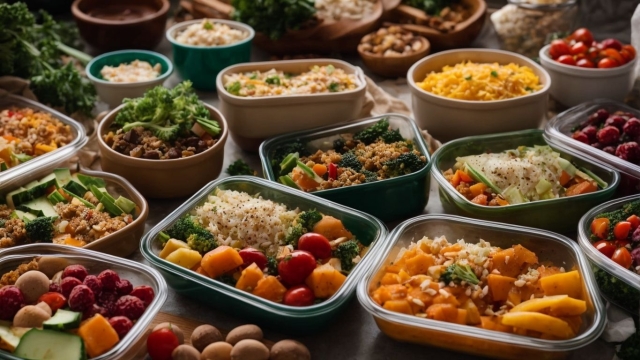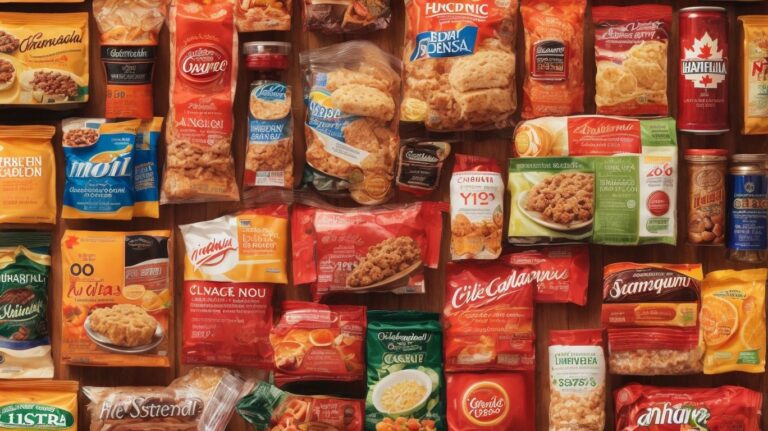How to Save Money on Groceries in Canada
.jpg)
Grocery shopping can be a significant expense, but with a little planning and strategy, it’s possible to save money on groceries in Canada. Implementing the following tips and techniques can help you stretch your budget and reduce your grocery expenses.
1. Plan Your Meals and Make a Grocery List: By planning your meals in advance and making a detailed grocery list, you can avoid impulse purchases and only buy what you need.
2. Compare Prices and Shop at Different Stores: Take the time to compare prices at different grocery stores and take advantage of sales and discounts to get the best deals on your groceries.
3. Take Advantage of Sales and Use Coupons: Keep an eye out for sales, promotions, and coupons that can significantly lower your grocery bill.
4. Buy in Bulk and Stock Up on Non-Perishable Items: Buying non-perishable items in bulk can save you money in the long run, especially for items that you use regularly.
5. Cook at Home and Avoid Eating Out: Eating out can be expensive, so try to cook at home as much as possible to reduce your food costs.
6. Purchase Generic or Store Brand Items: Opting for generic or store brand items can save you money without compromising on quality.
7. Use Cashback Apps and Loyalty Programs: Take advantage of cashback apps and loyalty programs offered by grocery stores to earn rewards and get discounts on your purchases.
8. Minimize Food Waste and Repurpose Leftovers: Minimize food waste by properly storing and using leftovers creatively to make new meals.
9. Grow Your Own Food or Join Community Gardens: Growing your own food or joining a community garden can help you save money on fresh produce.
10. Freeze and Preserve Excess Produce: If you have excess produce, consider freezing or preserving it for later use to avoid wastage.
In addition to these tips, there are several additional resources available in Canada that can provide more information and guidance on how to save money on groceries. By implementing these strategies and utilizing the available resources, you can significantly reduce your grocery expenses and save money in the long run.
Key takeaways:
- Plan your meals and make a grocery list: Planning your meals and creating a shopping list can help you avoid impulsive purchases and ensure you only buy what you need, saving you money in the process.
- Compare prices and shop at different stores: Don’t settle for the first store you come across. Comparing prices and shopping at different stores can help you find the best deals and save money on groceries.
- Take advantage of sales and use coupons: Keep an eye out for sales and discounts on groceries, and make use of coupons to further reduce your expenses. These small savings can add up significantly over time.
Tips on How to Save Money on Groceries in Canada
Looking to cut down your grocery expenses in Canada? Look no further! Discover a wealth of money-saving tips and tricks to help you stretch your budget in the supermarket aisles. From planning meals and making a savvy grocery list to taking advantage of sales and coupons, we’ve got your wallet covered. Want to know more? We’ll also explore the benefits of buying in bulk, cooking at home, and utilizing cashback apps and loyalty programs. Get ready to revolutionize your shopping routine and keep those dollars in your pocket!
1. Plan Your Meals and Make a Grocery List
Planning meals and making a grocery list can significantly help you save money on groceries in Canada. To begin, follow these steps:
- Assess your pantry and fridge to see what ingredients you already have.
- Decide on meals you want to prepare for the week and consider the ingredients needed.
- Create a detailed grocery list based on the meals you plan to make.
- Prioritize essential items and avoid impulse purchases.
- Take note of any special deals or discounts available and incorporate them into your list.
- Stick to your list while shopping to avoid unnecessary purchases.
- Consider seasonal produce and plan meals around what’s available and affordable.
- Opt for versatile ingredients that can be used in multiple dishes.
- Plan for leftovers and incorporate them into future meals to minimize waste.
- Review and adjust your meal plans and grocery list regularly based on your needs and budget.
2. Compare Prices and Shop at Different Stores
Comparing prices and shopping at different stores is a great way to save money on groceries in Canada. Here are some helpful tips to consider:
- Make sure to check flyers and online ads in order to compare prices at various stores.
- If you’re looking to make bulk purchases at lower prices, consider visiting discount stores or warehouse clubs.
- For fresh produce at competitive prices, think about shopping at local farmers markets.
- If you’re in search of specialty items or ingredients at affordable prices, explore ethnic grocery stores.
- Take advantage of loyalty programs or reward cards offered by stores to enjoy additional savings.
By comparing prices and shopping at different stores, you’ll be able to find the best deals and maximize your savings on groceries.
Historically, comparing prices and shopping at different stores has been a common strategy for thrifty shoppers looking to stretch their budgets. In the past, people used to travel from store to store, manually comparing prices and taking advantage of sales and promotions. However, thanks to the convenience of online shopping and price comparison websites, it’s now easier than ever to compare prices and find the best deals.
3. Take Advantage of Sales and Use Coupons
Taking advantage of sales and using coupons can be an effective way to save money on groceries in Canada. Here are some tips:
- Take Advantage of Sales: Keep an eye on weekly flyers and circulars to find out about sales and discounts.
- Use Coupons: Clip coupons from newspapers and magazines, or use digital coupons offered by grocery stores and coupon websites.
- Maximize Savings: Combine sales and coupons to maximize savings. Look for opportunities to stack coupons on top of discounted items.
- Sign up for Loyalty Programs: Sign up for loyalty programs at your favorite grocery stores to receive exclusive offers and discounts.
- Utilize Cashback Apps: Use cashback apps that offer rebates on grocery purchases.
4. Buy in Bulk and Stock Up on Non-Perishable Items
- One smart strategy to save money on groceries in Canada is to buy in bulk and stock up on non-perishable items.
- Here is a list of tips to help you make the most of this approach:
- Make a list of non-perishable items you regularly use, such as canned goods, pasta, rice, and cleaning products.
- Research prices and compare deals at different stores to find the best savings.
- Take advantage of sales and discounts to buy bulk items at a lower cost.
- Consider joining a warehouse club or buying from wholesale stores for bulk items.
- Store your non-perishable items properly to ensure their freshness and longevity.
- By buying in bulk and stocking up on non-perishable items, you can save money in the long run and have essential items readily available whenever you need them.
5. Cook at Home and Avoid Eating Out
- Cooking at home and avoiding eating out can significantly help save money on groceries in Canada.
- Here are some tips to make this a successful money-saving strategy:
- Create a weekly meal plan to avoid spontaneous meal purchases.
- Prepare meals in bulk and freeze leftovers for future use.
- Invest in cooking appliances like slow cookers or instant pots to simplify meal preparation.
- Try cooking international cuisines at home instead of dining out.
- Opt for homemade snacks and beverages instead of purchasing them from outside.
- By cooking at home and eliminating dining out, you can enjoy delicious meals while sticking to your budget!
6. Purchase Generic or Store Brand Items
- Purchasing generic or store brand items is a great way to save money on groceries.
- Generic brands offer similar quality as name brands at a lower cost.
- Store brand products are often produced by the retailer themselves.
- These items typically have simple packaging and fewer marketing expenses, resulting in lower prices.
- Buying generic or store brand items can save you up to 30% compared to name brands.
- Examples of generic or store brand items include canned goods, pasta, cereal, and cleaning supplies.
- Before making a purchase, compare prices and read labels to ensure you are getting the best value for your money.
7. Use Cashback Apps and Loyalty Programs
To save money on groceries in Canada, it is beneficial to utilize cashback apps and loyalty programs. Here are a few ways to optimize the advantages they offer:
- Make sure to download cashback apps such as Checkout 51 or Rakuten to earn cashback on your grocery purchases.
- To gain exclusive discounts, offers, and rewards, join loyalty programs at your preferred grocery stores.
- To maximize your savings, combine your cashback rewards with coupons and take advantage of sales.
- Ensure that you understand and meet the requirements of the cashback apps and loyalty programs in terms of earning rewards.
By implementing these strategies, you can effectively make the most of cashback apps and loyalty programs, ultimately saving money while grocery shopping in Canada.
8. Minimize Food Waste and Repurpose Leftovers
- Minimize Food Waste and Repurpose Leftovers: Incorporating these practices is a great way to save money on groceries and reduce environmental impact.
- Plan your meals: Before shopping, create a meal plan to ensure you only buy what you need.
- Store leftovers properly: Invest in good storage containers to keep leftovers fresh for longer.
- Use leftovers in new meals: Get creative and transform leftovers into new dishes, like using leftover chicken in a stir-fry or making a frittata with leftover vegetables.
- Make soups and stocks: Use vegetable scraps and leftover bones to make flavorful soups and stocks.
- Compost: If you can’t repurpose or eat leftover food, compost it to reduce waste and create nutrient-rich soil.
9. Grow Your Own Food or Join Community Gardens
Growing your own food or joining a community garden can be a cost-effective way to save money on groceries in Canada. Here is a list of benefits and tips to consider:
- Savings: By growing your own food or participating in community gardens, you can eliminate the expense of purchasing produce from the grocery store, resulting in significant savings over time.
- Control: Engaging in this practice gives you the ability to have complete control over what you grow. This ensures that your food is always fresh, organic, and free from pesticides.
- Health benefits: In addition to the financial aspect, gardening is also a physical activity that promotes exercise, reduces stress, and enhances overall well-being.
- Community engagement: To further enhance the experience, you can join a community garden. This will allow you to connect with like-minded individuals, exchange knowledge, and foster a sense of community.
- Space requirements: When considering whether to grow your own food, take into account the amount of available space. Whether it’s a backyard, balcony, or a shared community garden plot, make sure it suits your needs.
- Plant selection: Another important aspect is selecting plants that are well-suited for your region’s climate and align with your personal preferences.
- Maintenance: Successful gardening requires regular practices such as watering, fertilizing, and pest control. These practices are crucial for the health and growth of your plants.
- Harvesting and preserving: It’s important to be prepared for the time when your crops are ripe and ready for harvest. Additionally, learning preservation techniques will ensure you maximize the use of excess produce.
10. Freeze and Preserve Excess Produce
“`
- Freeze and preserve your excess produce is a great way to reduce food waste and save money on groceries. Follow these steps to effectively freeze and preserve your extra fruits and vegetables:
- Wash and thoroughly dry the produce.
- Cut or chop the produce into the desired size.
- Blanch the produce by briefly boiling or steaming it.
- Quickly cool the produce in an ice bath.
- Drain and pat dry the produce.
- Place the produce in freezer-safe containers or bags, removing as much air as possible.
- Label the containers with the name and date.
- Store the containers in the freezer at 0°F or below.
Pro-tip: When using the frozen produce, thaw it in the refrigerator overnight for the best texture and quality.
Additional Resources for Saving Money on Groceries in Canada
Looking for additional ways to save money on groceries in Canada? Here are some great resources:
- Check out coupon websites like Canadian Coupons and SmartSource, which offer both printable and digital coupons.
- Want exclusive deals and savings? Download grocery store apps from major chains like Walmart and Loblaws.
- Compare prices at different stores easily with apps such as Flipp and Reebee. Find the best deals with just a few clicks!
- Don’t forget to follow money-saving blogs like Mrs. January and Canadian Budget Binder. They provide insightful tips, strategies, and even coupon matchups.
Some Facts About How to Save Money on Groceries in Canada:
- ✅ Buying generic brands instead of name brands can save you 25% on groceries, especially for staples like sugar, salt, flour, and bleach. (Source: My Money Coach)
- ✅ Making a grocery list and sticking to it can save you up to 23% on your grocery bills. (Source: My Money Coach)
- ✅ Adding more fruits and vegetables to your diet can save you 25% on your grocery budget and help you lose weight. (Source: My Money Coach)
- ✅ Shopping at discount grocery stores like the Real Canadian SuperStore can save you at least 10% on groceries compared to other stores. (Source: My Money Coach)
- ✅ Shopping at discount produce stores or farmer’s markets can save you up to 32% on fruits and vegetables. (Source: My Money Coach)
Frequently Asked Questions
Q1: How can buying generic brands help save money on groceries in Canada?
A1: Buying generic brands instead of name brands can save you 25% on groceries, especially for staples like sugar, salt, flour, and bleach.
Q2: What is the benefit of making a grocery list and sticking to it?
A2: Making a grocery list and sticking to it can save you up to 23% on your grocery bills.
Q3: How can adding more fruits and vegetables to your diet save you money on groceries in Canada?
A3: Adding more fruits and vegetables to your diet can save you 25% on your grocery budget and help you lose weight.
Q4: How can shopping at discount grocery stores like the Real Canadian SuperStore help save money on groceries?
A4: Shopping at discount grocery stores like the Real Canadian SuperStore can save you at least 10% on groceries compared to other stores.
Q5: How can shopping at discount produce stores or farmer’s markets help save money on fruits and vegetables in Canada?
A5: Shopping at discount produce stores or farmer’s markets can save you up to 32% on fruits and vegetables.
Q6: How can requesting coupons from manufacturers help save money on groceries?
A6: Requesting coupons from manufacturers can save you around 10% on your groceries.
- How to Reduce Food Waste and Save Money - October 28, 2023
- Frugal Snack Ideas for Kids - October 27, 2023
- Top 10 Frugal Meal Ideas for Large Families - October 27, 2023





